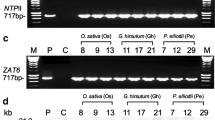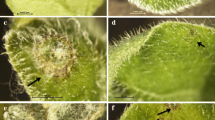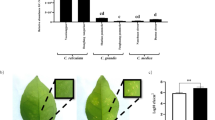Abstract
The 5′ flanking region of the CALTPI gene, which encodes a basic lipid transfer protein, was isolated and characterized from the genomic DNA of Capsicum annuum. Four different regions of the promoter sequence of the CALTPI gene were fused to the β-glucuronidase (GUS) coding region. In an Agrobacterium-mediated transient expression assay, the transcriptional activations of the promoter deletions were examined in tobacco leaves after infection with Pseudomonas syringae pv. tabaci, and treatment with ethylene and salicylic acid. The −808 bp region of the CALTPI gene promoter sequence exhibited full promoter activity. The W-box and ERE-box elements, which are essential for induction by all signals, were localized in the region between −555 bp and −391 bp upstream of the translation initiation site. A CALTPI transgene was then introduced under the control of the 35S promoter into the Arabidopsis ecotype Col-0. Transgenic Arabidopsis lines expressing the CALTPI gene developed rapidly compared to the wild-type plants, indicating that CALTPI may be involved in plant development. Overexpression of the CALTPI gene enhanced the resistance against infection by P. syringae pv. tomato and Botrytis cinerea. The transgenic plants expressing the CALTPI gene also showed high levels of tolerance to NaCl and drought stresses at various vegetative growth stages. No transcription of the PR-1, PR-2, PR-5, thionin, and RD29A genes was observed in untreated leaf tissues of the transgenic plants. The enhanced resistance to pathogen and environmental stresses in transgenic Arabidopsis correlated with the enhanced expression of the CALTPI gene.








Similar content being viewed by others
References
Berrocal-Lobo M, Molina A, Solano R (2002) Constitutive expression of ethylene-response-factor 1 in Arabidopsis confers resistance to several necrophic fungi. Plant J 29:23–32
Bradford MM (1976) A rapid and sensitive method for the quantitation of microgram quantities of protein utilizing the principle of protein-dye binding. Anal Biochem 72:248–254
Canevascini S, Caderas D, Mandel T, Fleming AJ, Dupuis I, Kuhlemeier C (1996) Tissue-specific expression and promoter analysis of the tobacco ltp1 gene. Plant Physiol 112:513–524
Clough SH, Bent AF (1998) Floral dip: a simplified method for Agrobacterium-mediated transformation of Arabidopsis thaliana. Plant J 16:735–743
Colmenero-Flores JM, Campos F, Garciarrubio A, Covarrubias AA (1997) Characterization of Phaseolus vulgaris cDNA clones responsive to water deficit: identification of a novel late embryogenesis abundant-like protein. Plant Mol Biol 35:393–405
Despres C, Subramaniam R, Matton DP, Brisson N (1995) The activation of the potato PR-10a gene requires the phosphorylation of the nuclear factor PBF-1. Plant Cell 7:589–598
Dunn MA, White AJ, Vural S, Hughes MA (1998) Identification of promoter elements in a low-temperature-responsive gene (blt4.9) from barley (Hordeum vulgare L.). Plant Mol Biol 38:551–564
Fleming AJ, Mandel T, Hofmann S, Sterk P, de Vries SC, Kuhlemeier C (1992) Expression pattern of a tobacco lipid transfer protein gene within the shoot apex. Plant J 2:855–86
Ge X, Chen J, Sun C, Cao K (2003) Preliminary study on the structural basis of the antifungal activity of a rice lipid transfer protein. Protein Eng 16:387–390
Gomès E, Sagot E, Gaillard C, Laquitaine L, Poinssot B, Sanejouand Y, Delrop S, Coutos-Thévenot P (2003) Nonspecific lipid transfer protein genes expression in grape (Vitis sp.) cells in response to fungal elicitor treatments. Mol Plant Microbe Interact 16:456–464
Guiderdoni E, Cordero MJ, Vignols F, Garcia-Garrido JM, Lescot M, Tharreau D, Meynard D, Ferrière N, Notteghem J, Deldeny M (2002) Inducibility by pathogen attack and developmental regulation of the rice Ltp1 gene. Plant Mol Biol 49:683–699
Herbers K, Meuwly P, Frommer WB, Métraux JP, Sonnewald U (1996) Systemic acquired resistance mediated by the ectopic expression of invertase: possible hexose sensing in the secretory pathway. Plant Cell 8:793–803
Higo K, Ugawa Y, Iwamoto M, Korenaga T (1999) Plant cis-acting regulatory DNA elements (PLACE) database. Nucleic Acids Res 27:297–300
Horvath BM, Bachem CWB, Trindade LM, Oortwijn MEP, Visser RGF (2002) Expression analysis of a family of ns LTP genes tissue specifically expressed throughout the plant and during potato tuber life cycle. Plant Physiol 129:1494–1506
Hughes MA, Dunn MA, Pearce RS, White AJ, Zhang L (1992) An abscisic acid-responsive, low temperature barley gene has homology with a maize phospholipid transfer protein. Plant Cell Environ 15:861–865
Iraki NM, Singh N, Bressen RA, Carpita NC (1989) Cell walls of tobacco cells and changes in composition associated with reduced growth upon adaptation to water and saline stress. Plant Physiol 91:48–53
Jefferson RA, Kavanagh TA, Bevan MW (1987) GUS fusions beta-glucuronidase as a sensitive and versatile gene fusion marker in higher plants. EMBO J 6:3901–3907
Joshi CP (1987) An inspection of the domain between putative TATA box and translation start site in 79 plant genes. Nucleic Acids Res 15:6643–6653
Jung HW, Hwang BK (2000) Pepper gene encoding a basic β-1,3-glucanase is differentially expressed in pepper tissues upon pathogen infection and ethephon or methyl jasmonate treatment. Plant Sci 159:97–106
Jung HW, Kim W, Hwang BK (2003) Three pathogen-inducible genes encoding lipid transfer protein from pepper are differentially activated by pathogens, abiotic, and environmental stresses. Plant Cell Environ 26:915–928
Kader JC (1996) Lipid transfer proteins in plants. Annu Rev Plant Physiol Plant Mol Biol 47:627–654
Katagiri F, Thilmony R, He SY (2002) The Arabidopsis thaliana-Pseudomonas syringae interaction. In: Somerville CR, Meyerowitz EM (ed) The Arabidopsis book. American Society of Plant Biologists, Rockville
Kim SY, Chung HJ, Thomas TL (1997) Isolation of a novel class of bZIP transcription factors that interact with ABA-responsive and embryo-specification elements in the Dc3 promoter using a modified yeast one-hybrid system. Plant J 11:1237–1251
Knight H, Brandt S, Knight MR (1998) A history of stress alters drought calcium signaling pathways in Arabidopsis. Plant J 16:681–687
Maldonodo AM, Doerner P, Dixon RA, Lamb CJ, Cameron RK (2002) A putative lipid transfer protein involved in systemic resistance signaling in Arabidopsis. Nature 419:399–403
Meshi T, Iwabuchi M (1995) Plant transcription factors. Plant Cell Physiol 36:1405–1420
Mittler R, Shulaev V, Lam E (1995) Coordinated activation of programmed cell death and defense mechanisms in transgenic tobacco plants expressing a bacterial proton pump. Plant Cell 7:29–42
Molina A, Garcia-Olmedo F (1993) Developmental and pathogen-induced expression of three barley genes encoding lipid transfer protein. Plant J 4:983–991
Molina A, Garcia-Olmedo F (1997) Enhanced tolerance to bacterial pathogens caused by the transgenic expression of barley lipid transfer protein LTP2. Plant J 12:669–675
Molina A, Segura A, Garcia-Olmedo F (1993) Lipid transfer protein (nsLTPs) from barley and maize leaves are potent inhibitors of bacterial and fungal plant pathogens. FEBS Lett 316:119–122
Molina A, Diaz I, Vasil IK, Carbonero P, Garcia-Olmedo F (1996) Two cold-inducible genes encoding lipid transfer protein LTP4 from barley show differential responses to bacterial pathogens. Mol Gen Genet 252:162–168
Montgomery J, Goldman S, Deikman J, Margossian L, Fischer RL (1993) Identification of an ethylene-responsive region in the promoter of a fruit ripening gene. Proc Natl Acad Sci USA 90:5939–5943
Nielson KK, Nielson JE, Madrid SM, Mikkelsen JD (1996) New antifungal proteins from sugar beet (Beta vulgaris L.) showing homology to non-specific lipid transfer proteins. Plant Mol Biol 31:539–552
Oh SA, Park J, Lee GI, Paek KH, Park SK, Nam HG (1997) Identification of three genetic loci controlling leaf senescence in Arabidopsis thaliana. Plant J 12:527–535
Penninckx IAMA, Eggermont K, Terras FRG, Thomma BPHJ, De Samblanx GW, Buchala A, Metrux JP, Manners JM, Broekaert WF (1996) Pathogen-induced systemic activation of a plant defensin gene in Arabidopsis follows a salicylic acid-independent pathway. Plant Cell 8:2309–2323
Rathjen J, Chang JH, Staskawicz B, Michelmore RW (1999) Constitutively active Pto induces a Prf-dependent hypersensitive response in the absence of avrPto. EMBO J 18:3232–3240
Rogers EE, Ausubel FM (1997) Arabidopsiss enhanced disease susceptibility mutant exhibit enhanced susceptibility to several bacterial pathogens and alterations in PR-1 gene expression. Plant Cell 9:305–316
Sambrook J, Fritsch EF, Maniatis R (1989) Molecular cloning: a laboratory manual, 2nd edn. Cold Spring Harbor Laboratory Press, Cold Spring Harbor
SAS Institute (1990) SAS user’s guide, version 6, 4th edn, vol 1. SAS institute, Cary
Segura A, Moreno M, Garcia-Olmedo F (1993) Purification and antipathogenic activity of lipid transfer proteins (LTPs) from the leaves of Arabidopsis and spinach. FEBS Lett 332:243–246
Sohal AK, Pallas JA, Jenkins GI (1999) The promoter of a Brassica napus lipid transfer protein gene is active in a range of tissues and stimulated by light and viral infection in transgenic Arabidopsis. Plant Mol Biol 41:75–87
Staehelin LA, Newcomb EH (2000) Membrane structure and membranous organelles. In: Buchanan B, Gruissem W, Jones RL (eds) Biochemistry and molecular biology of plants. ASPP Press, Rockville, pp 2–50
Stalberg K, Ellerstom M, Ezcurra I, Ablov S, Rask L (1996) Disruption of an overlapping E-box/ABRE motif abolished high transcription of the napA storage-protein promoter in transgenic Brassica napus seeds. Planta 199:515–519
Sterk P, Booij H, Schellekens GA, Van Kammen A, De Vries SC (1991) Cell-specific expression of the carrot EP2 lipid transfer protein gene. Plant Cell 3:907–921
Thoma S, Hecht U, Kippers A, Botella J, De Varies S, Somerville C (1994). Tissue-specific expression of a gene encoding a cell wall-localized lipid transfer protein from Arabidopsis. Plant Physiol 105:35–45
Torres-Schumann S, Godoy JA, Pintor-Toro JA (1992) A probable lipid transfer protein gene is induced by NaCl in stems of tomato plants. Plant Mol Biol 18:749–757
Trevino MB, O’Connell MA (1998) Three drought-responsive members of the nonspecific lipid-transfer protein gene family in Lyco persicon pennellii show different developmental patterns of expression. Plant Physiol 116:1461–1468
Yamaguchi-Shinozaki K, Shinozaki K (1994) A novel cis-acting element in an Arabidopsis gene is involved in responsiveness to drought, low-temperature, or high-salt stress. Plant Cell 6:251–264
Yang Y, Li R, Qi M (2000) In vivo analysis of plant promoters and transcription factors by agroinfiltration of tobacco leaves. Plant J 22:543–551
Yu D, Chen C, Chen Z (2001) Evidence for an important role of WRKY DNA binding proteins in the regulation of NPR1 gene expression. Plant Cell 13:1527–1540
Acknowledgements
This work was supported by the Korea Science and Engineering Foundation (grant no. R01-2000-000-00086-0), Crop Functional Genomics Center of the 21st Century Frontier Research Program (grant no. CG1432), and the Center for Plant Molecular Genetics and Breeding Research, Seoul National University, Korea. We thank Stuart Timmis for critically reading the manuscript.
Author information
Authors and Affiliations
Corresponding author
Rights and permissions
About this article
Cite this article
Jung, H.W., Kim, K.D. & Hwang, B.K. Identification of pathogen-responsive regions in the promoter of a pepper lipid transfer protein gene (CALTPI) and the enhanced resistance of the CALTPI transgenic Arabidopsis against pathogen and environmental stresses. Planta 221, 361–373 (2005). https://doi.org/10.1007/s00425-004-1461-9
Received:
Accepted:
Published:
Issue Date:
DOI: https://doi.org/10.1007/s00425-004-1461-9




